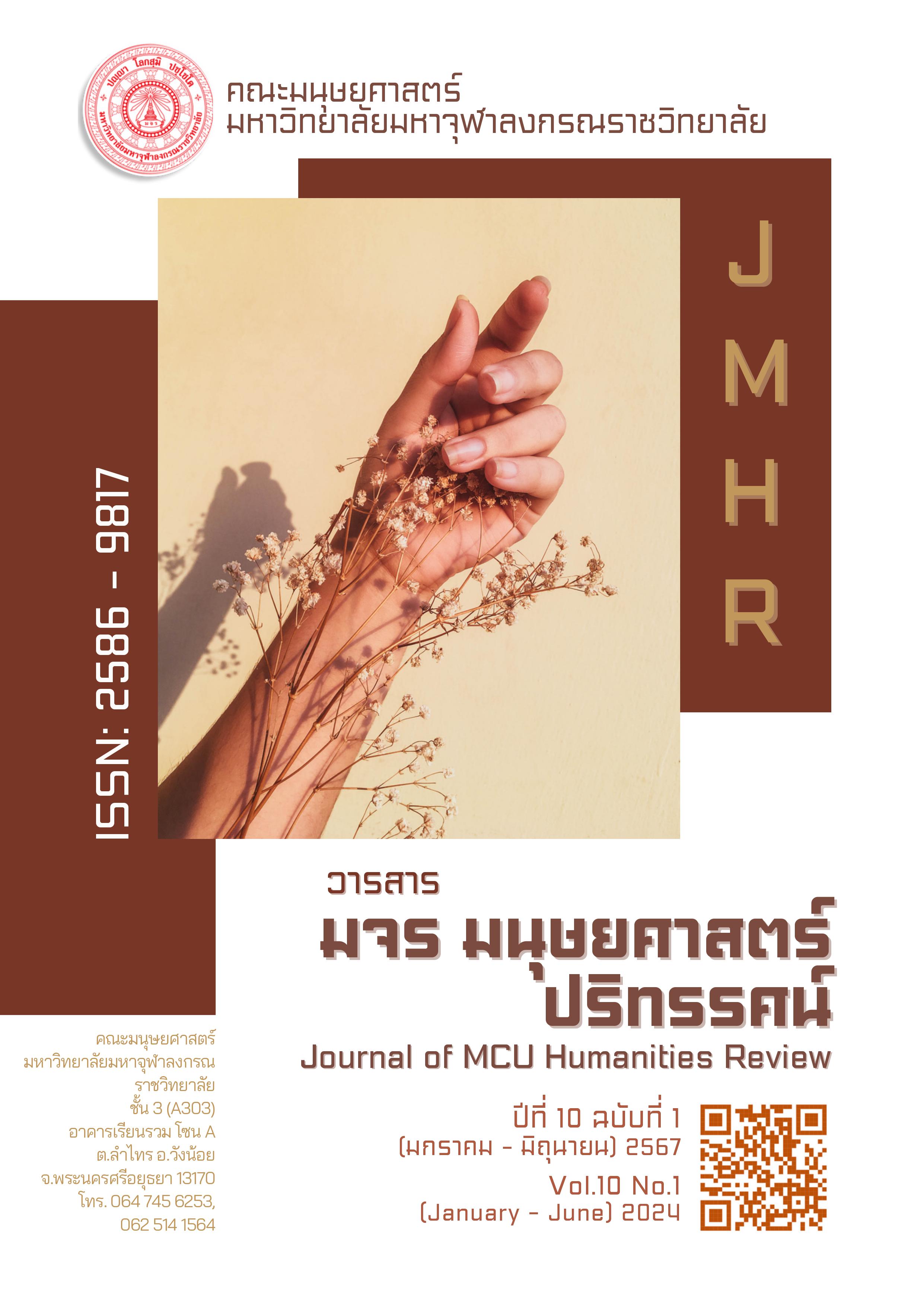การสอนสังคมตามแนวพุทธศาสต์ด้วยเทคนิค PSLDC MODEL 5 ขั้น
คำสำคัญ:
การสอนสังคมศึกษา, พุทธศาสตร์, PSLDC Modelบทคัดย่อ
การปฏิบัติการสำหรับการสอนสังคมศึกษา คือ กระบวนการหรือกิจกรรมที่ครูใช้เพื่อส่งเสริมการเรียนรู้ของนักเรียนในวิชาสังคมศึกษา โดยเน้นที่ให้นักเรียนเรียนรู้ผ่านประสบการณ์จริง เป็นวิธีที่มีประสิทธิภาพช่วยให้นักเรียนเข้าใจแนวคิดที่ซับซ้อนและสร้างความเข้าใจที่ลึกซึ้งยิ่งขึ้นได้อย่างยั่งยืนด้วยเทคนิค PSLDC Model 5 ขั้น สู่ความสำเร็จ เป็นรูปแบบการจัดการเรียนรู้ที่ยืดหยุ่น สามารถปรับเปลี่ยนให้เหมาะสมกับบริบทของสถานศึกษาและกลุ่มเป้าหมายของการเรียนรู้ ที่ผู้เขียนออกแบบขึ้น ประกอบด้วย 5 ขั้นตอน คือ ขั้นตอนที่ 1 P : Plan วางแผน เป็นขั้นตอนที่ครูกำหนดจุดประสงค์การเรียนรู้ เนื้อหาสาระ กิจกรรมการเรียนรู้ สื่อการเรียนรู้ และการประเมินผลการเรียนรู้ ขั้นตอนที่ 2 S : Structure โครงสร้าง เป็นขั้นตอนที่ครูออกแบบโครงสร้างการเรียนรู้ โดยพิจารณาจากจุดประสงค์การเรียนรู้ เนื้อหาสาระ และกิจกรรมการเรียนรู้ ขั้นตอนที่ 3 L : Link เชื่อมโยง เป็นขั้นตอนที่ครูเชื่อมโยงความรู้เดิมกับความรู้ใหม่ โดยพิจารณาจากเนื้อหาสาระและกิจกรรมการเรียนรู้ ขั้นตอนที่ 4 D : Design ออกแบบ เป็นขั้นตอนที่ครูออกแบบกิจกรรมการเรียนรู้ โดยพิจารณาจากจุดประสงค์การเรียนรู้ เนื้อหาสาระ โครงสร้างการเรียนรู้ และความรู้เดิมของนักเรียน และ ขั้นตอนที่ 5 C : Conclusion สรุปผล เป็นขั้นตอนที่ครูสรุปผลการเรียนรู้ โดยพิจารณาจากกิจกรรมการเรียนรู้และการประเมินผลการเรียนรู้ การจัดการเรียนรู้ตามแบบ PSLDC 5 ขั้น สู่ความสำเร็จ ช่วยให้ผู้เรียนเกิดการเรียนรู้อย่างมีประสิทธิภาพ โดยผู้สอนจะต้องวางแผนการจัดการเรียนรู้อย่างรอบคอบออกแบบกิจกรรมการเรียนรู้ที่หลากหลาย เชื่อมโยงความรู้เดิมกับความรู้ใหม่และสรุปผลการเรียนรู้ของผู้เรียน
เอกสารอ้างอิง
กระทรวงศึกษาธิการ. (2560). หลักสูตรแกนกลางการศึกษาขั้นพื้นฐาน พุทธศักราช 2551 ฉบับปรับปรุง พ.ศ. 2560. กรุงเทพฯ : สำนักงานคณะกรรมการการศึกษาขั้นพื้นฐาน.
จุฑาพร เกตุแก้ว. (2561). สอนสังคมศึกษาอย่างไรให้เด็กคิดวิเคราะห์ (พิมพครั้งที่ 2). กรุงเทพฯ : สำนักพิมพ์ ซีเอ็ดยูเคชั่น.
ปาณจิตร สุกุมาลย์. (2565). การบูรณาการหลักพุทธวิธีการสอนในการสอนสังคมศึกษา. วารสาร มจร อุบลปริทรรศน์, 7(1), 977 - 990.
บุญรอด บุญทวี. (2559). ทฤษฎีและแนวทางการสอนสังคมศึกษา. กรุงเทพฯ : สำนักพิมพ์มหาวิทยาลัยรามคำแหง.
พระครูอุทิตปริยัติสุนทร. (2566). การออกแบบการเรียนรู้เชิงรุกด้านการทำงานเป็นทีมรายวิชาพระพุทธศาสนาชั้นมัธยมศึกษาปีที่ 5 ของโรงเรียนมัธยมศึกษาในจังหวัดอุทัยธานี (รายงานการวิจัย). สถาบันวิจัยพุทธศาสตร์: มหาวิทยาลัยมหาจุฬาลงกรณราชวิทยาลัย.
พระมหาโกวิทย์ ฐานเมธี. (2565). พุทธปรัชญากับศาสตร์การสอนสังคมศึกษา. วารสาร มจร อุบลปริทรรศน์, 7(3), 257 - 268.
ราชกิจจานุเบกษา. (2562). พระราชบัญญัติการศึกษาแห่งชาติ พ.ศ. 2542 (ฉบับที่ 4) แก้ไขเพิ่มเติม พ.ศ. 2562. เล่มที่ 130 ตอนที่ 57 ก หน้า 1, ลงวันที่ 18 สิงหาคม พ.ศ. 2562.
วลัย อิศรางกูร ณ อยุธยา. (2554). หลักการและแนวทางการสอนสังคมศึกษา. กรุงเทพฯ : สำนักพิมพาจุฬาลงกรณ์มหาวิทยาลัย.
สถาบันส่งเสริมการสอนวิทยาศาสตร์และเทคโนโลยี. (2564). แนวทางการจัดการเรียนรู้วิชาสังคมศึกษา ศาสนาและวัฒนธรรม. กรุงเทพฯ : สถาบันส่งเสริมการสอนวิทยาศาสตร์และเทคโนโลยี.
สุรพล กาญจนกูล. (2561). การประยุกต์ใช้หลักพุทธปรัชญาในการจัดการเรียนรู้สังคมศึกษา. วารสารมหาวิทยาลัยราชภัฏสวนสุนันทา, 26(2), 121-134.
ดาวน์โหลด
เผยแพร่แล้ว
รูปแบบการอ้างอิง
ฉบับ
ประเภทบทความ
หมวดหมู่
สัญญาอนุญาต
ลิขสิทธิ์ (c) 2024 วารสาร มจร มนุษยศาสตร์ปริทรรศน์

อนุญาตภายใต้เงื่อนไข Creative Commons Attribution-NonCommercial-NoDerivatives 4.0 International License.






